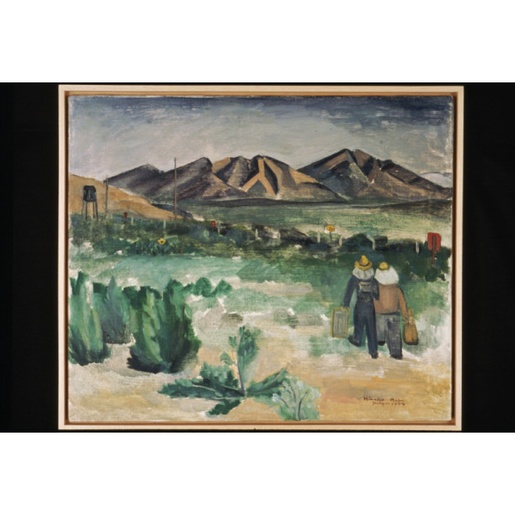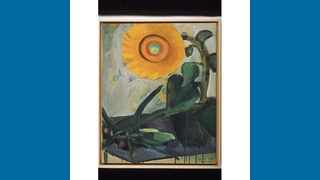Published: July 28, 2007
Modified: Feb. 11, 2025
After some time, the prisoners were allowed to go out on small, monitered excursions outside of the barbed wire boundaries. On these trips, some people found arrowheads belonging to native american tribes that had once inhabited the area, topaz, and other "treasures." We must remember that although they were allowed outside of the gates, they were still being watched, as is apparent from the presence of the guard tower here.
--
Description
Unframed stretched canvas. Image of two men walking in a field with a guard tower in the background. Thee are signs on a fence and mountains beyond the field.
Inscription
Signed, LR: Hisako Hibi / July 1944 ; BACK: When WRA regulations were eased a little, we were allowed to go out some part of the restricted area a bit of freedom we enjoyed going out we had to cover up our faces, hands and legs because there were many mosquitos + insects + so on 'Hisako Hibi Going to pick some shells'
History
After some time camp administrators decided to allow internees outside the barbed wire fence into restricted areas. Many internees took advantage of these opportunities to take little excursions. Parents and children often went in search of arrowheads, evidence of the former Native American civilization that occupied the area. The area where Topaz was located was also rich with fossil remains and actual semi-precious Topaz stones. Internees often gathered the small bits of Topaz to fashion into jewelry and crafts. Hibi wrote about going on this kind of "treasure hunt" with her family and the need to be covered virtually from head to toe, in order to protect themselves from the mosquitoes. In this painting Hibi depicts two internees going out on their "treasure hunt", appropriately dressed according to Hibi's description. Red and yellow warning signs dot the barbed wire fence that remained around the camp perimeter. Despite the taste of freedom offered by this rare opportunity, the guard tower and fence remain as reminders that the freedom offered was still limited.
painting
H: 22 in, W: 26 in
canvas
oil
Topaz, Utah, July 1944
(96.601.33)
Gift of Ibuki Hibi Lee
Hisako Hibi Collection
To see other collections:
Japanese American National Museum Collections Online
Copyright is held by the Japanese American National Museum. Short-term educational use with limited circulation is permitted. For all other uses, please contact the Hirasaki National Resource Center at the Japanese American National Museum (hnrc@janm.org)










